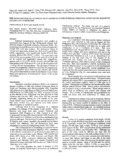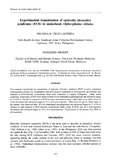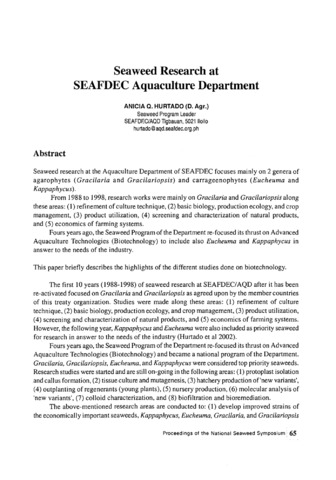Characterization of a virus obtained from snakeheads Ophicephalus striatus with epizootic ulcerative syndrome (EUS) in the Philippines
Share
| dc.contributor.author | Lio-Po, Gilda D. | |
| dc.contributor.author | Traxler, Garth S. | |
| dc.contributor.author | Albright, Lawrence J. | |
| dc.contributor.author | Leaño, Eduardo M. | |
| dc.date.accessioned | 2011-10-23T17:41:19Z | |
| dc.date.available | 2011-10-23T17:41:19Z | |
| dc.date.issued | 2000 | |
| dc.identifier.citation | Lio-Po, G. D., Traxler, G. S., Albright, L. J., & Leaño, E. M. (2000). Characterization of a virus obtained from snakeheads Ophicephalus striatus with epizootic ulcerative syndrome (EUS) in the Philippines. Diseases of Aquatic Organisms, 43(3), 191–198. | en |
| dc.identifier.issn | 0177-5103 | |
| dc.identifier.uri | http://hdl.handle.net/10862/665 | |
| dc.description | SEAFDEC main author, ISI-CC covered journal. Open Access Journal. Full text available. | en |
| dc.description.abstract | This is the first report of the isolation and characterization of a fish virus from the Philippines. The virus was isolated using snakehead spleen cells (SHS) from severely lesioned epizootic ulcerative syndrome (EUS)-affected snakehead Ophicephalus striatus from Laguna de Bay, in January 1991. The virus induced cytopathic effects (CPE) in SHS cells yielding a titer of 3.02 x 106 TCID50 ml-1 at 25°C within 2 to 3 d. Other susceptible cell lines included bluegill fry (BF-2), catfish spleen (CFS) and channel catfish ovary (CCO) cells. Replication in chinook salmon embryo cells (CHSE-214) was minimal while Epithelioma papulosum cyprini cells (EPC) and rainbow trout gonad cells (RTG 2) were refractory. Temperatures of 15 to 25°C were optimum for virus replication but the virus did not replicate at 37°C. The virus can be stored at -10 and 8°C for 30 and 10 d, respectively, without significant loss of infectivity. Viral replication was logarithmic with a 2 h lag phase; viral assembly in the host cells occurred in 4 h and release of virus occurred 8 h after viral infection. A 1-log difference in TCID50 titer between the cell-free virus and the total virus was noted. Freezing and thawing the virus caused a half-log drop in titer. Viral exposure to chloroform or heating to 56°C for 30 min inactivated the virus. Exposure to pH 3 medium for 30 min resulted in a more than 100 fold loss of viral infectivity. The 5-iododeoxyuridine (IUdR) did not affect virus replication, indicating a RNA genome. Neutralization tests using the Philippine virus, the ulcerative disease rhabdovirus (UDRV) and the infectious hematopoietic necrosis virus (IHNV) polyvalent antisera showed slight cross-reaction between the Philippine virus antiserum and UDRV but established no serological relationship with SHRV and IHN virus. Transmission electron microscopy (TEM) of SHS cells infected with the virus showed virus particles with typical bullet morphology and an estimated size of 65 x 175 nm. The Philippine virus was therefore a rhabdovirus, but the present study did not establish its role in the epizootiology of EUS. | en |
| dc.language.iso | en | en |
| dc.publisher | Inter Research | en |
| dc.relation.uri | http://www.int-res.com/articles/dao/43/d043p191.pdf | |
| dc.subject | Epizootic ulcerative syndrome (EUS) | en |
| dc.subject | Fish rhabdoviruses | en |
| dc.subject | Characterization | en |
| dc.subject | Channa striatus | en |
| dc.subject | Snakehead | en |
| dc.subject | Cell susceptibility | en |
| dc.subject | Philippines, Luzon I., Laguna de Bay | en |
| dc.title | Characterization of a virus obtained from snakeheads Ophicephalus striatus with epizootic ulcerative syndrome (EUS) in the Philippines | en |
| dc.type | Article | en |
| dc.citation.volume | 43 | |
| dc.citation.issue | 3 | |
| dc.citation.spage | 191 | |
| dc.citation.epage | 198 | |
| dc.citation.journalTitle | Diseases of Aquatic Organisms | en |
| dc.subject.asfa | fish diseases | en |
| dc.subject.asfa | laboratory culture | en |
| dc.subject.asfa | pathogens | en |
| dc.subject.asfa | pathology | en |
| dc.subject.asfa | replication | en |
| dc.subject.asfa | viral diseases | en |
| dc.subject.asfa | virulence | en |
| dc.identifier.doi | 10.3354/dao043191 | |
| dc.subject.scientificName | Ophicephalus striatus | |
| dc.subject.scientificName | Channa striata |
このアイテムのファイル
| ファイル | サイズ | フォーマット | 閲覧 |
|---|
このアイテムは次のコレクションに所属しています
-
AQD Journal Articles [1249]
These papers were contributed by AQD staff to various national and international journals



